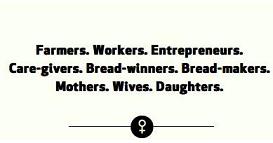 These few words from the ‘The Face of Female Farming’ aptly capture some of the roles and responsibilities of women in our society. Yesterday, the world celebrated the 101th year of International Women’s Day. Today, we continue to celebrate and honor women and girls worldwide by highlighting some interesting work and articles produced by the World Bank in the field of gender over the past year.
These few words from the ‘The Face of Female Farming’ aptly capture some of the roles and responsibilities of women in our society. Yesterday, the world celebrated the 101th year of International Women’s Day. Today, we continue to celebrate and honor women and girls worldwide by highlighting some interesting work and articles produced by the World Bank in the field of gender over the past year.
Gender Equality and Development
“Child marriages have stopped. Girls are being sent to school. Even the poorest of us are sending our daughters to school.” – Adult Man, India
This and many other such voices, presented in the World Development Report (WDR) 2012 qualitative assessments, indicate the progress we have made in terms narrowing gender gaps in education. Girls now outnumber boys in secondary schools in 45 developing countries and globally four out of every ten workers is a woman. However, at the same time, as WDR 2012 points out, nearly 4 million women go missing each year in developing countries and about two-fifths of girls are never born due to a preference for sons.
Widowhood and Welfare Effects
For a woman, widowhood has a lasting impact in terms of her well-being, living standards, and intergenerational transmission of poverty. Taking the context of the Malian Society, World Bank research finds that households headed by widows have significantly lower living standards on average than male or other female headed households in both rural and urban areas. Furthermore, the adverse welfare effects of widowhood appear to persist even after widows are absorbed into male headed households.
Regularization of Land Tenure and Gender
Gender bias has often existed in matters of inheritance. But with proper regulations and programs, such bias can diminish. A World Bank research paper, focusing on Rwanda's nation-wide land tenure regularization program, finds that tenure regularization not only improved land access for legally married women, but also prompted better recordation of inheritance rights without gender bias.
Soil Endowments and Missing Women
Despite real advances in the field of gender equality, gender imbalances still persist in many parts of the developing world. In India, gender imbalances have been worsening according to the 2011 census survey. While factors such as selective abortion and preference for sons largely explain these imbalances, they fail to clarify the heterogeneous nature of these imbalances. A recent research paper argues that across India, a largely agrarian economy, varied soil texture and the technology used in land preparation determine the use of female labor in cultivation tasks. It further finds that deep tillage reduces the participation of women in cultivation tasks and has a negative impact on the relative value of girls to a household. The analysis also finds that soil texture explains a large part of the variation in women's relative participation in agriculture and in infant sex ratios across districts in India.
Access to Finance and Women
The WDR 2012 on ‘Gender Equality and Development,’ emphasizes on the economics of gender equality. It says ‘gender equality is smart economics.’ Despite this, many women in developing countries face difficulties accessing finance. In developing countries, starting and growing a business is tougher for women than for men. According to Sri Mulyani Indrawati, “They often face less favorable borrowing terms and are more likely to pay higher interest rates than men.” In a blog post titled “Think Finance, Think Access, Think Equal,” she identifies gender inequality in legal regimes across the world as one of the reasons for this imbalance. “Financial barriers are significant and removing them has a huge poverty alleviation and growth potential,” says Indrawati.
Gender Equality: Time is now!
Greater gender equality can increase productivity, improve outcomes for children, make institutions more representatives, and improve development prospects for all. Then why wait? “A good start would be for some of those high-level global discussions -- and decisions -- on growth, prosperity, financial systems, and violence, to begin to factor in the potential role of the forgotten fifty percent of the world's population. Let's not leave it till the next generation,” says Caroline Antsy in “Women: Let's Not Leave It to the Next Generation” on the Huffington Post.


Join the Conversation